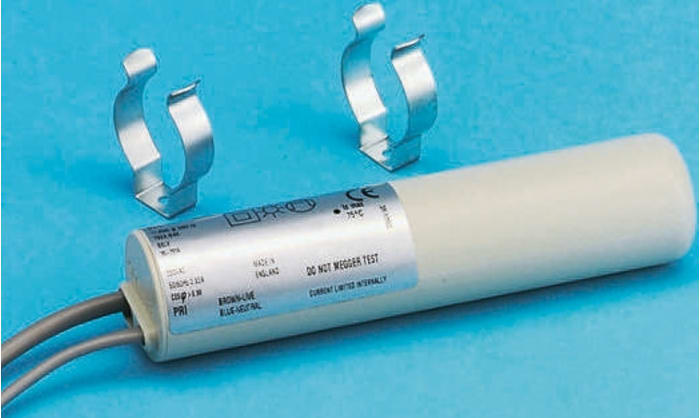Documents techniques
Spécifications
Brand
RS ProTension au primaire
230 → 240V ac
Tension au secondaire
11.5V
Gamme de puissance
10 → 60W
Dimensions
86 x 31 x 20 mm
Longueur
86 mm
Largeur
31 mm
Profondeur
20 mm
Exigence d'une charge minimale
10W
Température maximale
+45°C
Masse
50 g
Type d'application
Electronic
Gradation
Dimmable
Méthode de gradation
Bord de fuite
Fréquence de fonctionnement minimale
50Hz
Type de borne
Screw
Caractéristiques de protection
Protection contre les surtensions, protection contre la surchauffe, protection contre les surcharges, protection contre les courts-circuits
Fréquence de fonctionnement maximale
60Hz
Pays d'origine
Italy
Détails du produit
Mini-transformateur électronique réglable - PW60
Transformateur indépendant certifié IP20 pour lampes halogènes de 12 V.
Protection classe II contre les chocs électriques suivant des contacts directs et indirects
Très compact
Fourni avec capot de protection et fixation de câble
Bornes d'entrée et de sortie sur le même côté (zone de bornier 2,5 mm²)
Vis de serrage sur circuits primaires et secondaires pour les câbles avec diamètre minimum de 3 mm et maximum de 8 mm
Dépose de gaine de câble maximum 18 mm.
Le transformateur peut être fixé à l'aide de fentes filetées
Protégé contre la surchauffe et les court-circuits, les pics de tension et les surcharges de secteur
Low Voltage Lighting Transformers
Dimming Methods (where applicable):
Leading Edge:
The control device is either a thyristor or triac which blocks power until they are switched on by the control signal. At that point the current flows almost instantaneously and continues to flow until the end of the half cycle of the mains waveform. When the signal reaches zero, the device turns off and no more current is passed until it is triggered again. Turning the power on and off in this manner averages out creating a constant intensity level and by altering the precise trigger point over a period of time the lamp can be dimmed.
Trailing Edge:
Since this method of dimming uses transistor technology it is not limited to just switching, therefore current can be controlled gradually. Transistors can be programmed to pass current at the start of each half cycle, and gradually switch off later. This will control the full amount of power reaching the lamp without the side effects of a step increase in current.
€ 11,63
€ 11,63 Each (hors TVA)
1
€ 11,63
€ 11,63 Each (hors TVA)
Les informations sur le stock sont temporairement indisponibles.
1
Les informations sur le stock sont temporairement indisponibles.
Documents techniques
Spécifications
Brand
RS ProTension au primaire
230 → 240V ac
Tension au secondaire
11.5V
Gamme de puissance
10 → 60W
Dimensions
86 x 31 x 20 mm
Longueur
86 mm
Largeur
31 mm
Profondeur
20 mm
Exigence d'une charge minimale
10W
Température maximale
+45°C
Masse
50 g
Type d'application
Electronic
Gradation
Dimmable
Méthode de gradation
Bord de fuite
Fréquence de fonctionnement minimale
50Hz
Type de borne
Screw
Caractéristiques de protection
Protection contre les surtensions, protection contre la surchauffe, protection contre les surcharges, protection contre les courts-circuits
Fréquence de fonctionnement maximale
60Hz
Pays d'origine
Italy
Détails du produit
Mini-transformateur électronique réglable - PW60
Transformateur indépendant certifié IP20 pour lampes halogènes de 12 V.
Protection classe II contre les chocs électriques suivant des contacts directs et indirects
Très compact
Fourni avec capot de protection et fixation de câble
Bornes d'entrée et de sortie sur le même côté (zone de bornier 2,5 mm²)
Vis de serrage sur circuits primaires et secondaires pour les câbles avec diamètre minimum de 3 mm et maximum de 8 mm
Dépose de gaine de câble maximum 18 mm.
Le transformateur peut être fixé à l'aide de fentes filetées
Protégé contre la surchauffe et les court-circuits, les pics de tension et les surcharges de secteur
Low Voltage Lighting Transformers
Dimming Methods (where applicable):
Leading Edge:
The control device is either a thyristor or triac which blocks power until they are switched on by the control signal. At that point the current flows almost instantaneously and continues to flow until the end of the half cycle of the mains waveform. When the signal reaches zero, the device turns off and no more current is passed until it is triggered again. Turning the power on and off in this manner averages out creating a constant intensity level and by altering the precise trigger point over a period of time the lamp can be dimmed.
Trailing Edge:
Since this method of dimming uses transistor technology it is not limited to just switching, therefore current can be controlled gradually. Transistors can be programmed to pass current at the start of each half cycle, and gradually switch off later. This will control the full amount of power reaching the lamp without the side effects of a step increase in current.




